Related Research Articles

The Inca Empire, also known as the Incan Empire and the Inka Empire, was the largest empire in pre-Columbian America. The administrative, political and military center of the empire was located in the city of Cusco. The Inca civilization arose from the Peruvian highlands sometime in the early 13th century. Its last stronghold was conquered by the Spanish in 1572.
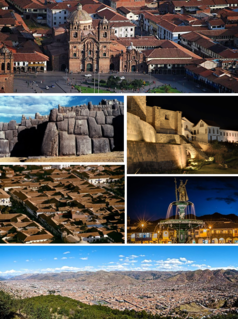
Cusco, often spelled Cuzco[ˈkusko], is a city in southeastern Peru near the Urubamba Valley of the Andes mountain range. It is the capital of the Cusco Region and of the Cusco Province. The city is the seventh most populous in Peru, and, in 2017, it had a population of 428,450. Its elevation is around 3,400 m (11,200 ft).

Viracocha is the great creator deity in the pre-Inca and Inca mythology in the Andes region of South America. Full name and some spelling alternatives are Wiracocha, Apu Qun Tiqsi Wiraqutra, and Con-Tici. Viracocha was one of the most important deities in the Inca pantheon and seen as the creator of all things, or the substance from which all things are created, and intimately associated with the sea.
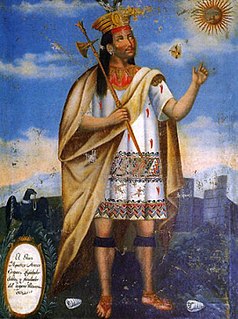
Manco Cápac, also known as Manco Inca and Ayar Manco was, according to some historians, the first governor and founder of the Inca civilization in Cusco, possibly in the early 13th century. He is also a main figure of Inca mythology, being the protagonist of the two best known legends about the origin of the Inca, both of them connecting him to the foundation of Cusco. His main wife was his older sister, Mama Uqllu, also the mother of his son and successor Sinchi Ruq'a. Even though his figure is mentioned in several chronicles, his actual existence remains uncertain.

Pachacamac is an archaeological site 40 kilometres (25 mi) southeast of Lima, Peru in the Valley of the Lurín River. The site was first settled around A.D. 200 and was named after the "Earth Maker" creator god Pacha Kamaq. The site flourished for about 1,300 years until the Spanish invaded. Pachacamac covers about 600 hectares of land.

Atahualpa, Atawallpa (Quechua), also Atabalica, Atahuallpa, Atabalipa (c. 1502–26 July 1533) was the last Inca Emperor. After defeating his brother, Atahualpa became very briefly the last Sapa Inca of the Inca Empire (Tawantinsuyu) before the Spanish conquest ended his reign.
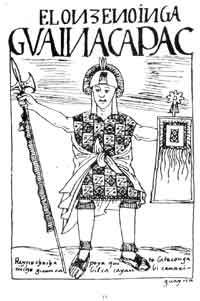
Huayna Capac, Guayna Cápac, Guayna Capac, Huain Capac,Guain Capac, Guayana Capac, Wayna Kapa, Wayn Capac, Wayana Qhapaq, Wayna Kapak,Wayna Capac, or Wayna Qhapaq (1464/1468–1524) was the third Sapan Inka of the Inca Empire, born in Tumipampa sixth of the Hanan dynasty, and eleventh of the Inca civilization. As other Sapa Inkas, Wayna Qhapaq subjects commonly approached him adding epithets and titles when addressing him, commonly as Wayna Qhapaq Inka Sapa'lla Tukuy Llaqt'a Uya "Unique Sovereign Wayna Qhapaq Listener of All Peoples". His original name was Titu Kusi Wallpa. He was the successor to Tupaq Inka Yupanki.

Sinchi Roca, Sinchi Rocca, Cinchi Roca, Sinchi Ruq'a or Sinchi Ruq'a Inka was the second Sapa Inca of the Kingdom of Cusco and a member of the Hurin dynasty.

The Inca religion was a group of beliefs and rites that were related to a mythological system evolving from pre-Inca times to Inca Empire. Faith in the Tawantinsuyu was manifested in every aspect of his life, work, festivities, ceremonies, etc. The population of the Tawantinsuyu didn't have an abstract concept of God and there was no word to define it. They were polytheists and there were local, regional and pan-regional divinities.

The Sapa Inca, Sapan Inka or Sapa Inka, also known as Apu ("divinity"), Inka Qhapaq, or simply Sapa, was the ruler of the Kingdom of Cuzco and later, the Emperor of the Inca Empire (Tawantinsuyu) and the Neo-Inca State. While the origins of the position are mythical and originate from the legendary foundation of the city of Cusco, it seems to have come into being historically around 1100 CE. Although the Inca believed the Sapa to be the son of Inti and often referred to him as Intip Churin or ‘Son of the Sun,’ the position eventually became hereditary, with son succeeding father. The principal wife of the Inca was known as the Coya or Qoya. The Sapa Inca was at the top of the social hierarchy, and played a dominant role in the political and spiritual realm.
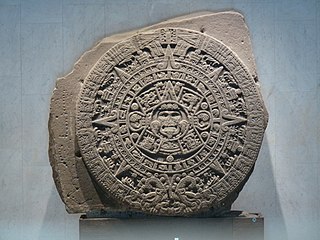
Pre-Columbian art refers to the visual arts of indigenous peoples of the Caribbean, North, Central, and South Americas until the late 15th and early 16th centuries, and the time period marked by Christopher Columbus' arrival in the Americas.

The Inti Raymi'rata is a traditional religious ceremony of the Inca Empire in honor of the god Inti, the most venerated deity in Inca religion. It was the celebration of the winter solstice - the shortest day of the year in terms of the time between sunrise and sunset - and the Inca New Year, when the hours of light would begin to lengthen again. In territories south of the equator, the Gregorian months of June and July are winter months. It is held on June 24.
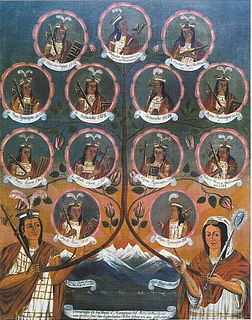
The Incas were most notable for establishing the Inca Empire in pre-Columbian America, which was centered in what is now Peru from 1438 to 1533, and represented the height of the Inca civilization. The Inca state was known as the Kingdom of Cuzco before 1438. Over the course or the Inca Empire, the Inca used conquest and peaceful assimilation to incorporate the territory of modern-day Peru, followed by a large portion of western South America, into their empire, centered on the Andean mountain range. However, shortly after the Inca Civil War, the last Sapa Inca (emperor) of the Inca Empire was captured and killed on the orders of the conquistador Francisco Pizarro, marking the beginning of Spanish rule. The remnants of the empire retreated to the remote jungles of Vilcabamba and established the small Neo-Inca State, which was conquered by the Spanish in 1572.

The Inca society was the society of the Inca civilization in Peru. The Inca Empire, which lasted from 1438 to 1533 AD, represented the height of this civilization. The Inca state was known as the Kingdom of Cusco before 1438. Over the course of the empire, the rulers used conquest and peaceful assimilation to incorporate a large portion of western South America, centred on the Andean mountain ranges. The empire proved relatively short-lived, however: by 1533, Atahualpa, the last Sapa Inca (emperor) of the Inca Empire, was killed on the orders of the conquistador Francisco Pizarro, marking the beginning of Spanish rule. The last Inca stronghold, the Neo-Inca State in Vilcabamba was conquered by the Spanish in 1572.
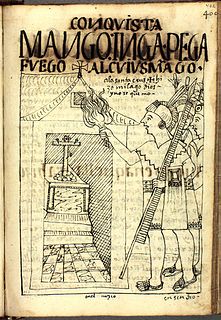
The Siege of Cusco was the siege of the city of Cusco by the army of Sapa Inca Manco Inca Yupanqui against a garrison of Spanish conquistadors and Indian auxiliaries led by Hernando Pizarro in the hope to restore the Inca Empire (1438–1533). The siege lasted ten months and was ultimately unsuccessful.

Inti is the ancient Incan sun god. He is revered as the national patron of the Inca state. Although most consider Inti the sun god, he is more appropriately viewed as a cluster of solar aspects, since the Inca divided his identity according to the stages of the sun. Worshiped as a patron deity of the Inca Empire, Pachacuti is often linked to the origin and expansion of the Inca Sun Cult. The most common story says that he is the son of Viracocha, the god of civilization.

Capacocha or Qhapaq hucha was an important sacrificial rite among the Inca that typically involved the sacrifice of children. Children of both genders were selected from across the Inca empire for sacrifice in capacocha ceremonies, which were performed at important shrines distributed across the empire, known as "huacas", or "wak'as".
Umu may refer to:

Inca mythology includes many stories and legends that attempt to explain or symbolize Inca beliefs.
The Tawantinsuyu or Inca Empire was a centralized bureaucracy. It drew upon the administrative forms and practices of previous Andean civilizations such as the Wari Empire and Tiwanaku, and had in common certain practices with its contemporary rivals, notably the Chimor. These institutions and practices were understood, articulated, and elaborated through Andean cosmology and thought. Following the Spanish conquest of the Inca Empire, certain aspects of these institutions and practices were continued.
References
- ↑ Prescott, W.H., 2011, The History of the Conquest of Peru, Digireads.com Publishing, ISBN 9781420941142
D'Altroy, Terence. the Incas. Malden MA: Blackwell Publishing, 2003